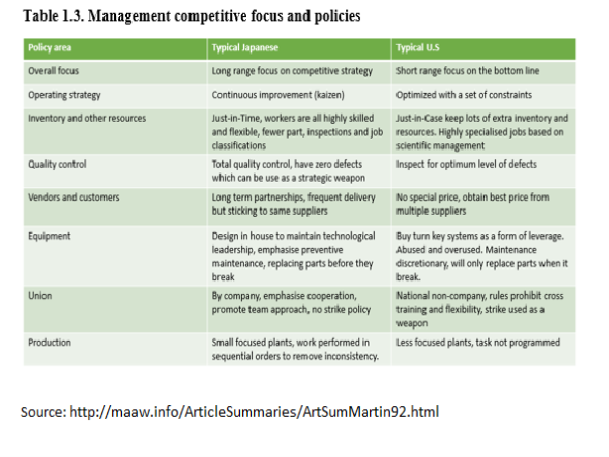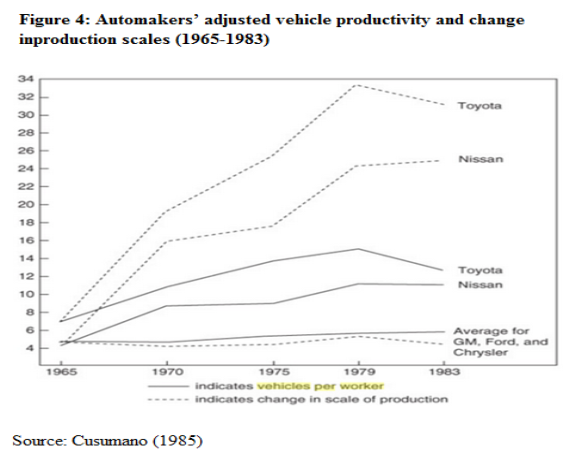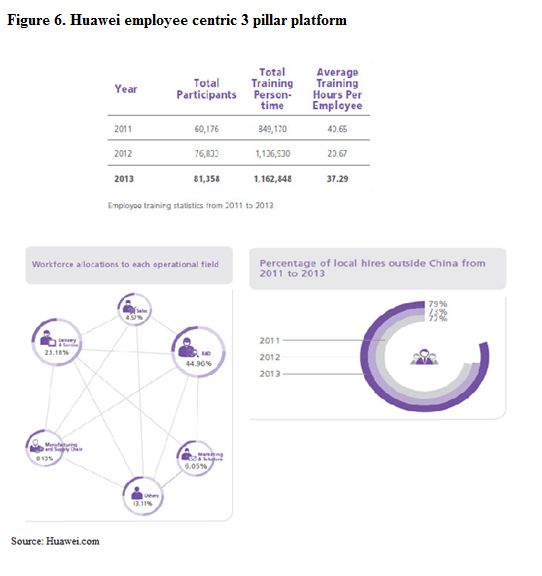National economic success rests on leadership in production systems
|
How accurate is the argument that national economic success rests on leadership in systems of production and operations management? |
|
Introduction
The national economic success rests on leadership in systems of production and operations management to a certain extent. Multinational Enterprises are huge contributors towards a country’s Gross Domestic Product (GDP), employment and growth of entrepreneurship,and attribute for job creations, innovations, technological improvements and economic wealth.Competition between service providers and manufacturers in every segment of business continue advancing as they race in terms of quality of production, comprehensive flow from selection of raw materials supply, delivery of finished goods or services to customers.The endless battles between corporate levels have spawned new innovation in terms of product development and also improved quality of services which further leads to the creation of competitive advantages.To provide comprehensive discussion, this paper will elaborate the different system that leads to competitive issues along with the provision of several corporate cases from automobile industry.Concerning the creation of competitive advantages, this emerges following the notion that production and operation has been a major preoccupation and is closely linked to productivity competitiveness and living standards.
Culture & Management Techniques Comparison
Toyota has shown consistent growth and profitability and it is their culture that led to their success. Employees were taught with a master-apprentice model whereby employees learn from their seniors. This is made possible as the majority of Toyota’s leaders spent their entire career at the company. The “Toyota Way” model is defined as a house with two pillars, respect for co-workers, stakeholders and customers; continuous improvement in business operations and people development at all levels of the organization. (Liker and Ogden, 2011)
Similar to the Japanese, German automobile maker Volkswagen believed in the continuous improvement model also known as the Combine (Windolf and Beyer, 1996). Volkswagen is able to “orchestrating a high number of people and focus on one common goal” (Koplin, Seuring and Mesterharm, 2007). A unique feature of the German corporate structure is that they have employee participation called “work council” where employees have the right to be comprehensively informed of pay matters and holiday reduction among other issues. Unlike the Japanese, Germans are willing to take risk in making major decisions; however the Japanese finds it difficult to alter their long-term strategy when disaster strikes.
Majority of large industrial Chinese company such as Chery are state owned thus benefitting from free or low-cost land, tax breaks and government protection. After China’s entry into the world trade organization in 2001, development of domestic brands in the automobile industry became their top priority. Government favouritism is distinct with frequent visits from state leader and funding from state-owned banks. Most businesses in China started by imitating foreign designs; however the real challenge they face in the future is developing comparative advantage (Anderson, 2012).
The typical structure of capital networks in Britain is the inverted star model where a large corporation is made up of several companies however there is no formal organization. These companies do not have common interest and participation is limited leading to minimum liability. These co-ordinations of behaviour generally result from competition rather than co-operation. (Windolf and Beyer, 1996)
The following tables show general comparison overview of Japan and U.S’s management techniques and culture.




Production and Operations Management
Production and Operations management concerns conversion of inputs and outputs using their resources to deliver the desired product to the customer simultaneously achieving their organizational objectives of efficiency, and adoptability. It differentiates itself from other marketing, finance etc. by focusing on their primary concern which is conversion of physical resources. Figure 2 shows the 8 main factors of production and operation management (Heizer and Render, 1996).

Mass production is a manufacturing system using large scale production, assembly line and the use of interchangeable parts making it a basic to have in production lines (Piore, 1994; Sabel, 1985). As a partially assembled car moves down the assembly line, workers will place in the appropriate parts and will not wait if any fault occurs. Ford produces cars from interchangeable parts in 1908 (Guy, 2009). This system is created for managers to ensure that workers follow the standard procedures while operating the equipment, this uniformity allowed thousands of workers who are untrained to work leading to increased productivity (Guy, 2009). U.S was the leader in manufacturing in the early 20th century, the system of regulations that was a success in the U.S from the 1940s to 1970s is later known as Fordism (Guy, 2009). During the Fordism period, U.S was the dominant industrial country, among all the other capitalist countries; Europe and UK adopted the practice of Fordism techniques which was successful until the 1980s when challenged by Japan’s lean production technique. Many countries tried imitating the Toyota production system in the 1980s due to its success and popularity.
The Toyota Production System (TPS), is a unique “pull” system implemented throughout Toyota to prevent wastage in seven key areas (seen on Figure 1) which involved utmost cooperation of all employees, suppliers and technological advancement of machineries (Womack et.al, 2007). It enables lesser inventory upkeep as wastage is eliminated incurring lower cost. Customer demands are promptly and efficiently fulfilled by connecting all production activity to actual marketplace demand (Monden, 2011). TPS is based on two concepts; Jidoka and Just-in-Time (JIT) to ensure speed improvements in production, business processes, quality and service of their product(refer to Figure 2). According to Cusumano (1985), Toyota along with other Japanese companies avoid imitating foreign manufacturing techniques and focused on developing a more efficient production system that is tailored exclusively to the Japanese market in the post-war period. Toyota also stresses on product design/process as it aims to develop reliable and easily maintained products, by keeping its technology up-to-date, they are able to better serve their customers and its business processes. In all, the TPS enables Toyota to outperform its Western counterparts in various ways (seen on Figure 3) as they are able to manufacture faster with less defects at a lower cost in comparison to their western counterparts (Womack et al, 1990). Toyota is able to hold its market share despite competitor’s imitation due to good relationship with suppliers and workforce with labour cost kept minimal. Production efficiency allows them to surpass their competitors.
According to Lee and Fujimoto (2003), many Chinese automakers have adopted the Japanese production systems, mainly through strategic alliances which are characterized as the global standard for manufacturing: Toyota Production System and the lean production. For instance, the joint venture between First Automotive Works Group Corporation (FAW), a Chinese state-owned automotive manufacturer and Toyota in 2002 signified the commencement of a full-fledged TPS transfer which has now extended to other automobile companies. The increase in foreign direct investment (FDI), in the form of joint ventures and strategic alliance, brought about the rise in production of cars in China (refer to Figure 4) which also indicate economic growth (Gallagher, 2006).




Human Resource Development
Chandler emphasises the importance of achieving the “three-pronged investments” in manufacturing, marketing and distribution and management which enables the increase in volume of sales, recruit train potential managers, technology development and etc. in order to exploit the economies of scale and scope and become a first mover in an industry (Chandler ,1990).
Passia (1999) mentioned that diligent Japanese workers, life-long employment, independent labour unions that are usually cooperative with employers enable Japan to achieve high labor performance aiding in its economic success. Toyota believed that investments in employees were the key to their success (Liker, 2004).Toyota management system supports the idea of on-job-training to ensure that employees are able to utilize their maximum potential. A stable employment is created whereby lay-offs and dismissals are not readily made thus building trust between employees and management (Refer to Appendix A).
Unlike Japanese firms, U.K employers and employees shared an impersonal and task-oriented relationship. Managers are only concerned with employees’ wellbeing in their work environment; for instance, providing them with advanced equipment if needed to improve job efficiency. In the context of automobile firm Jaguar, a company representative communicates regularly with employees, managers and employee representatives updating them with essential information. .Jaguar work closely with their trade unions and employee consultative body to discuss any proposed changes, work together to formulate solutions regarding areas of concern (Noronha, 2013).
Germany is known for its sophisticated system of vocational education and training (VET), it bolstered the craft sector and soon other industries started to adopt VET (Koen, 2005). Similar to Japan, education is deemed a crucial factor in Germany. In Volkswagen, specialist training courses regarding production are conducted for employees. Unions have no control over the distribution of task; through a mixture of informal and formal negotiation processes, job classification can be flexibly altered (Thelen, 1991). For instance, Volkswagen allows employees with diminished capabilities and motivation in their current position to switch to a different posts; it is highly encouraged for employees to transfer to departments where they are more capable (Andrałojć, Kochalski and Skowron-Mielnik, 2013).
U.S is one of the biggest markets for skilled labour around the globe due to numerous top universities and R&D located in US. After the great recession, labour union in US only consists around 11% compared to Germany. Ever since 1920’s, Ford had prioritize employees as one of their valuable assets for mass production (O’Callaghan, 2009). They increase employee’s salary twice as much compared to other companies, in return of long working hours and productivity goals. However, employee’s retention was not taken into concern especially by Ford until they adopt United Auto Workers as the last company who signed in Detroit (Wood and Wood, 2003; Stepan-Norris and Zeitlin, 1996). Till today, ford value their employees more than anything else as stated on CNBC March, 2014, that labour union saved ford from its darkest hours (CNBC, 2014).
Workers in China are mostly unskilled compare to U.S and Japan, resulting in shortage of capable employees. Besides low-cost labours, China companies hope to differentiate themselves through innovation and vertical integration, depending on the characteristic of competition in theirsectors (Miltenburg, 1995; Doorman, 2012; Tang, 2010). Using Huawei as an example, it altered the human resource model in 2009, changing it from a function-based platform to an employee-centric three-pillar platform that includes faster employee development, employee’s safety and culture diversification (Figure 1) (Huawei.com, 2015). Xiang (2005) mentioned that labour unions are now strong enough to demand standard minimum wages leading to employee’s satisfaction and retention.

Conclusion
Leadership in systems of production and operations management played a huge role in a nation’s economic success due to cost and time efficiency. Investments in quality improvement eventually reduces internal and external failure cost while the increasing profit allows firms to be flexible to meet price reductions of its competitors, staying levelled or ahead of competitors (The University of Scranton Online, 2015). Supply-chain management encompasses the development of a product to customer delivery, therefore timely and cost-effective methods have to be developed to promptly meet demands. Human development and management techniques are value-added factors that allow firms to be more competitive and efficient, working towards the fundamental goal developed by the organization’s leader. Worker’s characteristic, policies and culture must also be taken into account in terms of management. Gross Domestic Product (GDP) is the value of goods and services produced in a country; therefore leadership in systems of production and operations management would lead to low unemployment and wage increase increasing social and environmental benefits for the population in the long run (Heizer and Render, 1996). Therefore leadership in systems of production and operations is slowly gaining importance in developing countries where manpower is not properly utilized. However in many developed nations, strengths of these industries have started diminishing due to higher labour, social cost and slowness in innovation have called for future transformations (Weihrich, 1999).
References
Anderson, G. (2012).Designated Drivers: How China Plans To Dominate The Global Auto Industry. Wiley.
AndraÅ‚ojć, M., Kochalski, C., & Skowron-Mielnik. (2013).Work organisation and innovation – Case study: Volkswagen PoznaÅ„, Poland. Dublin: European Foundation for the Improvement of Living and Working Conditions.
CNBC, (2014).Unions saved Ford in our ‘darkest’ hour: Bill Ford. [online] CNBC. Available at: http://www.cnbc.com/id/101529786.
Cusumano, M. (1985).The Japanese automobile industry. Cambridge, Mass.: Published by the Council on East Asian Studies, Harvard University and distributed by the Harvard University Press.
Data.worldbank.org, (2015).Population, total | Data | Table. [online] Available at: http://data.worldbank.org/indicator/SP.POP.TOTL.
Doorman, F. (2012).Crisis, economics, and the emperor’s clothes. [S.l.]: Lulu.
Gallagher, K. (2006).China shifts gears. Cambridge, Mass.: MIT Press.
Guy.F (2009). The global environment of business. Oxford: Oxford University Press
Heizer, J. and Render, B. (1996).Production and operations management. Upper Saddle River, N.J.: Prentice Hall.
Huawei.com, (2015).Caring for Employees – About Huawei. [online] Available at: http://huawei.com/en/about-huawei/sustainability/win-win-development/caring-employees/index.htm.
Koen, C. (2005). Comparative international management. London: McGraw-Hill Education.
Koplin, J., Seuring, S. and Mesterharm, M. (2007). Incorporating sustainability into supply management in the automotive industry – the case of the Volkswagen AG.Journal of Cleaner Production, 15(11-12), pp.1053-1062.
Lee, C. and Fujimoto, T. (2003). The Chinese Automobile Industry and the Strategic Alliances of China, Japan and US Firms. Discussion Paper for International Motor Vehicle Program, Boston, MA: MIT.
Liker, J. (2004). The Toyota way. New York: McGraw-Hill.
Liker, J. and Ogden, T. (2011).Toyota under fire. New York: McGraw-Hill.
Miltenburg, J. (1995).Manufacturing strategy. Portland, Or.: Productivity Press
Monden, Y. (2011).Toyota production system. Portland, Or.: Taylor & Francis.
Noronha, C. (2013). ‘Developing our people for growth is the key at JLR’ – Jaguar Land Rover – Tata in Europe. [online] Europe.tata.com. Available at: http://www.europe.tata.com/Section/Article/Developing-our-people-for-growth-is-the-key-at-JLR?sectid=eLiVfqUiZks=
O’Callaghan, T. (2009).Ford in the service of America. Jefferson, N.C.: McFarland & Co.
Passia, (1999).Training and Education in International Affairs: Japan, Palestine and the Middle East (1999). [online] Available at: http://www.passia.org/seminars/99/japan/content.html
Piore, Micheal J, 1994. Corporate Reform in American Manufacturing and the Challenge to Economic Theory. In Information Technology and the Corporation of the 1990s. : Research Studies, edited by T.J.Allen and M.S.Scott Morton. New York: Oxford University Press
Sable, C. and Jonathan, Z. (1985). Historical Alternatives to Mass Production: Politics, Markets and Technology in Ninetieth-Century Industrialization. Past and Present 108: 133-76
Stepan-Norris, J. and Zeitlin, M. (1996).Talking union. Urbana: University of Illinois Press.
Tang, F. (2010).Marketing strategies of Chinese companies. Hamburg: Diplomica Verlag.
Thelen, K. (1991). Union of parts. Ithaca: Cornell University Press.
The University of Scranton Online, (2015).5 Management Traits of Operations Leaders. [online] Available at: http://elearning.scranton.edu/resource/business-leadership/5-management-traits-of-operations-leaders.
Toyota, (2003). Human Resources Development. [online] Toyota.co.jp. Available at: http://www.toyota.co.jp/en/environmental_rep/03/jyugyoin03.html
Toyota, (2003). Labor-Management Relations. [online] Toyota.co.jp. Available at: http://www.toyota.co.jp/en/environmental_rep/03/jyugyoin.html
Weihrich, H. (1999). Analyzing the competitive advantages and disadvantages of Germany with the TOWS Matrix †an alternative to Porter’s Model.European Business Review, 99(1), pp.9-22.
Wimmer, E. and Muni, A. (2012).Motoring the future. Houndmills, Basingstoke, Hampshire: Palgrave Macmillan.
Windolf, P. and Beyer, J. (1996). Co-operative Capitalism: Corporate Networks in Germany and Britain.The British Journal of Sociology, 47(2), p.205.
Womack, J., Jones, D. and Roos, D. (2007).The machine that changed the world. New York: Free Press.
Wood, J. and Wood, M. (2003).Henry Ford. London: Routledge.
Xiang, J. (2005).China focus, 2004-2005. [Beijing?]: China Intercontinental Press. 60-63
APPENDIX A
